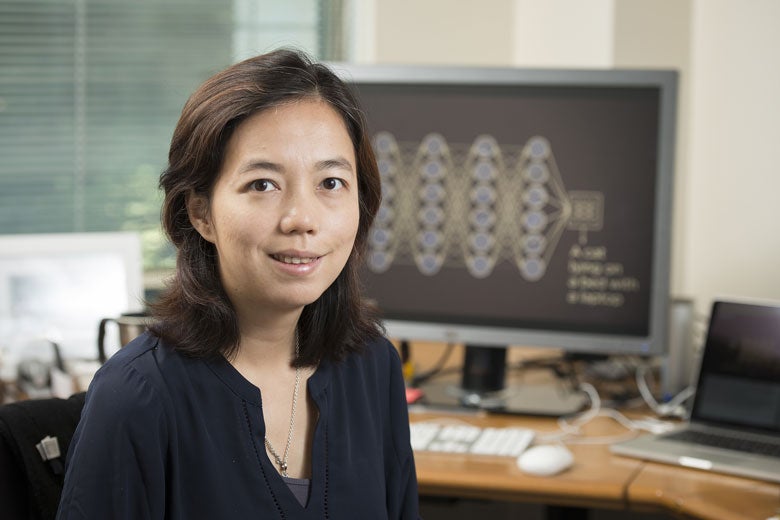Artificial intelligence is integrated into daily life, although often in imperceptible ways, such as language translators or algorithms that provide shopping tips based on past purchases. The next wave of AI-enabled devices that interact with humans will be far more obvious – think intelligent robotics and autonomous cars – and will become a driving force in reshaping society and individual lives.

Fei-Fei Li, associate professor of computer science and director of the Stanford Artificial Intelligence Lab, will direct the new SAIL-Toyota Center for AI Research. (Image credit: L.A. Cicero)
In a critical step toward that future, today Stanford announced the formation of the SAIL-Toyota Center for AI Research, a new research center funded by $25 million from Toyota to further the development of artificial intelligence technologies. The collaboration is part of a combined effort by Toyota, Stanford and MIT, where Toyota is also funding a parallel research center, to advance the state of autonomous systems, with a goal of reducing traffic casualties and assisting drivers in various ways.
“The Stanford School of Engineering has a strong track record of leading innovation in artificial intelligence,” said Persis Drell, dean of Stanford School of Engineering. “This support will enable us to expand our research in human-centered AI and innovate solutions to some of the world’s most pressing challenges.”
The collaboration builds on decades of leading-edge AI research conducted at Stanford. In the 1960s, the Stanford Artificial Intelligence Lab, or SAIL, built some of the first chess-playing computers, and by the 1970s, the Stanford Artificial Intelligence Language was one of the predominant tools for programming AI platforms. More recently, Stanford researchers have built systems that have aced several autonomous driving competitions.
Early on, the new effort will focus on AI-assisted driving. This is in part because of an obvious need – according to the World Health Organization, 3,400 people die a day due to automobile-related accidents – but also because it is a particularly good challenge for developing AI methodologies and platforms.
“AI-assisted driving is a perfect platform for advancing fundamental human-centric artificial intelligence research while also producing practical applications,” said Fei-Fei Li, an associate professor of computer science at Stanford, director of SAIL and the director of the new AI center. “Autonomous driving provides a scenario where AI can deliver smart tools for assistance in decision making and planning to human drivers.”
Driving might seem like a simple task, but that’s in large part because the human brain is remarkably good at collecting visual information, figuring out what’s important and then making snap behavioral decisions, all while staying within the framework of traffic laws. The brain performs this task nonstop, but the moment attention wanders – to text messaging, adjusting the radio or chatting with passengers – the door opens to accidents.
Mimicking the brain’s performance in an ever-changing environment makes autonomous driving one of the benchmark tasks for AI, even more so considering the life-saving potential of the application. Li, a world-renowned expert in computer vision, said that Stanford will tackle the problem by addressing four main challenges of making a computer think like a person: perception, learning, reasoning and interaction.
Stanford’s computer scientists will train computers to recognize objects and speech as well as data, and then use machine learning and statistical modeling to extract the meaningful data points – for instance, a swerving car versus a parked one. Other researchers will teach the AI platform to look at this critical data set and plot the safest driving action.
The first cars with AI technology will work as partners with the driver to make safe decisions, Li said, so devising ways to carefully and comfortably share control between the human and the computer will be instrumental in this technology gaining the public’s trust.
“These are fundamental issues in establishing human-centric AI,” said Juan Carlos Niebles, the associate director of research at the new Stanford center. “With the changes brought about by AI, the next generation of driving machines and driving experiences will be fundamentally different.”
In addition to the Stanford center, Toyota is also funding the Toyota-CSAIL Joint Research Center at MIT. The MIT center will be led by Daniela Rus, and will focus on developing advanced decision-making algorithms that allow autonomous vehicles to make safe driving decisions with and without human input. Gill Pratt, the former program director at the Defense Advanced Research Project Agency’s Defense Sciences Office, will coordinate Toyota’s academic collaboration with MIT and Stanford.
Media Contacts
Bjorn Carey, Stanford News Service: (650) 725-1944, bccarey@stanford.edu